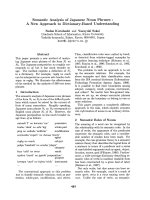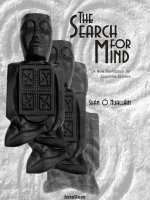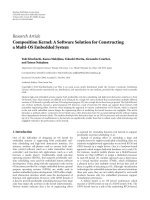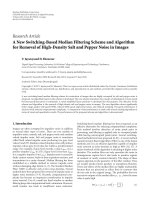Utilization of ECDLP for constructing a new certificate based digital signature
Bạn đang xem bản rút gọn của tài liệu. Xem và tải ngay bản đầy đủ của tài liệu tại đây (282.59 KB, 7 trang )
International Journal of Computer Networks and Communications Security
VOL. 3, NO. 2, FEBRUARY 2015, 33–42
Available online at: www.ijcncs.org
E-ISSN 2308-9830 (Online) / ISSN 2410-0595 (Print)
Utilization of ECDLP for Constructing a New Certificate Based
Digital Signature
Leili Abedi-Ostad1 and Morteza Nikooghadam2
1, 2
Department of Computer Engineering, University of Imam Reza, Mashhad 91735-553, Iran
E-mail: ,
ABSTRACT
Digital signatures that are used to achieve the integrity along with the authentication could be classified into
various types. PKI based, ID based, certificate based and certificateless digital signatures are the most
important types. Regarding advantages of certificate-based signatures (CBS), we want to propose a CBS
scheme by means of employing elliptic curve discrete logarithm problem (ECDLP).The proposed scheme’s
security is proven under the elliptic curve discrete logarithm assumption in the random oracle model.
Results of comparing our scheme with existing pairing-free certificate-based signature schemes, shows that
ours has much lower computational cost.
Keywords: Elliptic Curve Discrete Logarithm Problem, Certificate-Based Digital Signature, Random
Oracle Model, Pairing-Free, Elliptic Curve Cryptography.
1
INTRODUCTION
In traditional public key cryptography (PKC), the
public key of user should be certified by
certification authority (CA). This approach has
difficulties for managing certificates. For solving
this problem, Shamir [1] presented identity based
cryptography (IBC), which means user’s public key
is made of his/her unique identity. In this scheme,
private key of user is created by a private key
generator (PKG). Since PKG has private key of all
users, he/she can impersonate them. This problem
is called key escrow [2].
There are two schemes for solving this problem.
One of them is certificateless public key
cryptography (CL-PKC). This scheme was
presented by Al-Riyami and Paterson [3]. In this
scheme, a key generating center (KGC) has to
create user’s partial private key. The private key is
made of the partial private key and a random secret
value that is selected by the user. Since users select
their own public key, there is no way for
authentication of declared public key. This problem
leads to key replacement attack [4]. The other
scheme is certificate-based cryptography (CBE)
which was presented by Gentry [2]. In this scheme
all users make their private and public key.
Afterwards CA produces a certificate for each user
by using his/her identity and public key.
Certificate-based signature (CBS) was proposed
by Kang et al. [5]. In this scheme, similar to CBE,
private and public keys are created by the user; then
CA creates a certificate based on user’s public key
and his/her identity. A signer by knowing his/her
certificate and private key can produce a valid
signature. In [4-10] many certificate-base
signatures based on pairing operation were
proposed. In 2000, Koblitz et al. [11] found out that
the computational cost of exponentiation operation
is much more than the cost of scalar multiplication
on the elliptic curve group. In 2007, Chen et al. [12]
realized that the computational cost of pairing is
twenty times more than scalar multiplication over
the elliptic curve group. Since cryptography
protocols without pairing have much lower cost
than pairing-based protocols, Liu et al. [13]
suggested one pairing-free CBS schemes. Zhang
[14] demonstrated that the proposed pairing-free
CBS scheme in [13] was insecure. In 2009, Ming
and Wang [15] and Zhang et al. [16] suggested
schemes without pairing. Li et al. [10] suggested
two secure CBS schemes against key replacement
attack. In 2012, Li et al. [17] suggested a short CBS
scheme which had one pairing operation. Li et al.
[18] in 2013 proposed a new CBS scheme under the
34
L. Abedi-Ostad and M. Nikooghadam / International Journal of Computer Networks and Communications Security, 3 (2), February 2015
discrete logarithm assumption and secure in
random oracle model.
We want to propose a CBS scheme by employing
ECDLP. We will show that our scheme is secure
under the elliptic curve discrete logarithm
assumption in the random oracle model. Compared
to existing CBS schemes, ours has much lower
computational cost.
At first, we give some definitions. Then you can
see our suggested CBS scheme and its security
analysis. Efficiency comparison of our scheme and
conclusion are at the end of this paper.
2
STRUCTURE OF CBS
hash
functions
*
H 0 : {0,1}* G G Z n*
H 1 : {0,1} G G G
*
Z n*
*
,
and
Z n*
H 2 : {0,1} {0,1} G G G
.
E
Publishes
{F p ,
, G , P , Qc , H 0 , H 1 , H 2 }
Fp
as
system parameters and preserves the master key x.
UserKeyGen: This algorithm gets parameters,
chooses x ID Z n* randomly as the user private key
and then calculates PK ID x ID .P as the user
public key.
Certify: This algorithm gets parameters, master
secret key x, user public key PK ID and user
Setup: It gets a security parameter, and gives the
system public parameters and the certifier’s master
secret key.
UserKeyGen: It gets the system public
parameters, and gives a secret key and a public key.
Certify: It gets system public parameters, master
secret key, the identity of a user and its public key.
Then its output is the user certificate.
Sign: It gets system public parameters, a
message, the user’s identity and his/her certificate,
public key and secret key. Its output is a signature.
Verify: It gets a message/signature pair, system
parameters, user’s public key and his/her identity.
Its output is 0 or 1. Value 1 indicates a valid
signature, and 0 is for an invalid signature.
identity ID {0,1}* . Randomly picks s Z n* and
3
Calculates z ( R x ID .h1 r.h2 ) mod n .
SECURITY MODEL
computes W s.P ,
R s x.h0 mod n .
h0 H 0 ( ID, PK ID , W )
and
The output is the user’s
certificate Cert ID R , W .
User will validate his/her certificate by checking
the equation R.P W y.H 0 ( ID, PK ID , W ) .
Sign: It gets parameters, user identity ID, user
private key x ID , user certificate Cert ID and
message
m {0,1}* . The algorithm works as
follows: Chooses r Z n* randomly and computes
U r.P . Calculates h1 H 1 (m, PK ID , U , W ) and
h2 H 2 (m, ID, PK ID , U , W ) .
According to [4, 5 and 18], we should consider
adversary and adversary. Adversary is a malicious
user who can be anyone except the CA. He can’t
gain the certificate of the other users but he can
change their public keys. He can’t gain the CA’s
master secret key, either. Adversary is a malicious
CA who has a master secret key but is not able to
change the user’s public key. We use the same
security model in [18] for analyzing security of
proposed scheme.
The signature is U , W , z .
4
If the equality holds, the output is 1; if not, the
output is 0.
The reason that the verification equation holds for
valid signatures is:
(2)
W y.h0 PK ID .h1 U .h2
SUGGESTED CBS SCHEME
Setup: This algorithm gets security parameter k
and outputs system parameters and master key. CA
proceeds as follows:
Selects a k-bit prime p and determines the tuple
E
{F p ,
, G, P, H 0 , H 1 , H 2 } . Selects the master
Fp
private key x Z n* and calculates the master public
key y x.P . Selects three cryptographic secure
Verify: Takes parameters, user public key PK ID
and message/signature pair (m, ) and computes
h0 H 0 ( ID, PK ID , W ) , h1 H 1 (m, PK ID , U ,W ) ,
h2 H 2 (m, ID, PK ID , U , W ) .
This algorithm examines the equation:
z.P W y.h0 PK ID .h1 U .h2
s.P x.h0 .P x ID .h1 .P r.h2 .P
( s x.h0 ).P x ID .h1 .P r.h2 .P
R. p x ID .h1 .P r.h2 .P
( R x ID .h1 r.h2 ).P
z.P
(1)
35
L. Abedi-Ostad and M. Nikooghadam / International Journal of Computer Networks and Communications Security, 3 (2), February 2015
In Figure 1, Setup, UserKeyGen and Certify steps
and in Figure 2, Sign and Verify steps are shown.
Signer
(2) Selects
Computes
∈
=
∗
randomly
.
and
∈ {0,1} ∗
=〈 ,
(4) Certificate Verification:
. = + . 0( ,
,
CA
(1) Chooses ∈ ∗ randomly
Computes = .
Chooses 0 , 1 and 2
Publishes { , , , , , 0 , 1 ,
〉
(3) Randomly picks ∈ ∗
Computes = . ,
Computes ℎ0 = 0 ( ,
,
Computes = + . ℎ0
2}
)
)
Fig. 1. Interactions between the signer and CA
Signer
(1) Chooses ∈ ∗ randomly
Computes = .
Computes ℎ1 = 1 ( ,
, , )
and ℎ2 = 2 ( , ,
, , )
=( +
. ℎ1 + . ℎ2 )
The signature is = 〈 , , 〉
Verifier
and ( , )
(2) Computes ℎ0 = 0 ( ,
, )
Computes ℎ1 = 1 ( ,
, , )
Computes ℎ2 = 2 ( , ,
, , )
Signature Verification:
. = + . ℎ0 +
. ℎ1 + . ℎ2
Fig. 2. Interactions between the signer and the verifier
5
SECURITY ANALYSIS
Theorem 1: (Game I). Let AI be a Type I
adversary against proposed CBS scheme in random
oracle model and runs at most t in polynomial time,
makes at most q H 0 (for i = 0,1,2) H i queries, q r
PKReplace queries, qe certification queries,
qc
corruption queries, q k UserKeyGen queries and q s
sign queries and wins the Game I with a
probability . An algorithm B can solve the
ECDLP with a probability in polynomial time
t , where
(3)
qe qs
1
1
1
,
q H 0
q H 0
t 2t (q k 2q e 4q s )t e (q e q s )t m
The multiplication operation in Z n* takes time t e
and addition operation in i j takes time t m in the
random oracle model.
E
Proof: Let ( F p ,
, G , P, Q .P) be a random
Fp
instance of the ECDLP selected by B as input. B
wants to output . Hash functions are considered
as random oracles. For consistence, B requires
keeping five initially empty lists Lk , Le , L0 , L1 , L2 .
List Lk keeps the UserKeyGen queries and
PKReplace queries; list Le keeps certification
queries and lists L0 , L1 , L2 keep H i queries. At
first B sets the master public key y Q .P and
E
gives system parameters F p ,
, G, P, y to AI .
Fp
Then, B randomly selects an index j such that
1 j q H 0 , where q H 0 is the number of queries in
36
L. Abedi-Ostad and M. Nikooghadam / International Journal of Computer Networks and Communications Security, 3 (2), February 2015
We note that first
defined, B selects x IDi Z n* randomly and puts
j th query to the
PK IDi x IDi .P . Then B adds ( IDi , x IDi , PK IDi )
random oracle H 0 and j should be selected.
Algorithm B will simulate oracles and interact with
the adversary AI as follows:
UserKeyGen Query: This algorithm gets a user’s
identity IDi . Then B verifies the list Lk to see
to the list Lk and transfers xIDi to AI . Otherwise,
the random oracle H 0 .
ID j ID * where ID j is the
whether IDi has been inserted before or not. If it
was not defined, B selects x IDi Z n* randomly
and
puts PK IDi x IDi .P .
Then
B
adds
it sends back the defined value.
Certification Query: This algorithm gets IDi and
PK IDi , then B responds as follows:
If i j , B verifies the list Le to see whether IDi
has been inserted before or not. If not, B selects
two random numbers d i and Ri Z n* and computes
Wi Ri .P d i . y . Then B verifies the list L0 to
( IDi , x IDi , PK IDi ) to the list Lk and transfers
see whether ( IDi , PK IDi , Wi ) has been inserted
PK IDi to AI . Otherwise, it sends back the defined
before or not. If it was defined before, B must
reselect d i and Ri Z n* . Otherwise B adds
value.
H 0 Query: This algorithm gets ( IDi , PK IDi , Wi ) ,
Then B verifies the list L0 to see whether H 0 has
been inserted before for that input or not. If it was
not defined, B selects d i Z n* randomly and
sends it back as a hash value of ( IDi , PK IDi , Wi ) .
Then B adds ( IDi , PK IDi , Wi , d i ) to the list L0 .
Otherwise, it sends back the defined value.
H 1 Query: Gets (mi , PK IDi , U i , Wi ) . Then
B
verifies the list L1 to see whether H 1 has been
inserted before for that input or not. If it was not
defined, B selects ei Z n* randomly and sends it
back as a hash value of (mi , PK IDi , U i , Wi ) . Then
B adds
(mi , PK IDi , U i , Wi , ei )
to the list L1 .
Otherwise, it sends back the defined value.
H 2 Query: Gets (mi , IDi , PK IDi , U i , Wi ) . Then B
verifies the list L2 to see whether H 2 has been
inserted before for that input or not. If it was not
defined, B selects ci Z n* randomly and sends it
back as a hash value of (mi , IDi , PK IDi ,U i ,Wi ) .
Then B adds (mi , IDi , PK IDi , U i , Wi , ci ) to the list
L2 . Otherwise, it sends back the defined value.
PKReplace Query: This algorithm gets a user’s
i , and then B
identity IDi and public key PK ID
verifies the list Lk to see if IDi has been inserted
before or not. If it was defined,
B
puts
i and x IDi . Otherwise, B adds
PK IDi PK ID
i ) to the list Lk .
( IDi , , PK ID
( IDi , PK IDi , W , d i )
to
the
list
( IDi , PK IDi , Wi , Ri )
to
list
Le
Cert IDi Wi , Ri
L0 ,
and
adds
sends
to AI . Otherwise, it sends back
the defined value. If i j , B aborts.
Sign Query: This algorithm gets IDi and mi , then,
B makes UserKeyGen query and Corruption query
and gets PK IDi and xIDi . If x IDi , AI should
provide the matching secret key xIDi . Otherwise B
responds as follows:
If i j , B makes certification query and signs the
message
mi by using (Cert ID i , x ID i ) .
If i j , B selects e j , c j , z j , d i Z n* and computes
W j d j . y and U j c j 1 ( z j .P PK ID j .e j ) .
B sets H 0 ( ID j , PK ID j , W j ) d j ,
H 1 (m j , PK ID j , U j , W j ) e j
and
H 2 (m j , ID j , PK ID j , U j , W j ) c j .
If hash functions H 0 , H 1 and H 2 have been
defined before, B reselects the random values.
Otherwise, B adds ( ID j , PK ID j , W j , d j ) to the list
L0 , adds (m j , PK ID j ,U j ,W j , e j ) to the list L1
and adds (m j , ID j , PK ID j , U j , W j , c j ) to the list
L2 . Finally, (U j , W j , z j ) is given to AI .
Therefore,
AI
gives
a
forgery
signature
* U * ,W * , z * on message m * by considering
*
( ID * , PK ID
) . If ID * ID j , B aborts. If not, by
Corruption Query: This algorithm gets user’s
identity IDi , and then B verifies the list Lk to see
using the forking lemma [19], B repeats AI with
if IDi has been inserted before or not. If it was not
different oracle H 0 but the same random tape.
37
L. Abedi-Ostad and M. Nikooghadam / International Journal of Computer Networks and Communications Security, 3 (2), February 2015
Then
B
can get another valid signature
*
*
U , W , z . So,
picks an index j such that 1 j q H 0 , where q H 0
is the number of queries to the random oracle H 0 .
It is noticeable that first ID j ID * where ID j is
*
*
z .P W
y.h0*
*
PK ID
.h1*
*
.h2*
U
*
z .P W * y.h0 PK ID
.h1* U * .h2*
(4)
(5)
From these two forgeries,
B can compute
*
z z
* ' , so B has solved the ECDLP. B can
h0 h0
obtain the value of if Pr E1 E 2 E 3 where
E1 :
B
does not fail while responding oracle
queries, E 2 : AI wins and E 3 : If ID * ID j .
From
the
simulation,
we
have
q q
e
s
1
,
Pr E1 1
Pr E 2 E1 ,
q H 0
1
Pr E3 E1 E 2
thus the success probability
q H0
q q
e
s
1
1
of B solving ECDLP is
1
q H 0
q H 0
. Algorithm B’s running time t is two times of the
AI ’s running time t and the time required to
answer oracle queries and the time to solve the
ECDLP. Totally
B
running time is
t 2t (q k 2qe 4q s )t e (q e q s )t m . □
the j th query to the random oracle H 0 and j
should be selected. Algorithm B will simulate
oracles and interact with the adversary AII as
follows:
UserKeyGen Query: This algorithm gets a user’s
identity IDi . Then B verifies the list Lk to see
whether IDi has been inserted before or not. If so,
the defined value is sent back. If not, B responds as
follows: If i j B chooses x IDi Z n* randomly
and sets
PK IDi x IDi .P . Then
B
adds
( IDi , x IDi , PK IDi ) to the list Lk and transfers
PK IDi to AII . If i j B puts PK ID j Q , then
adds ( ID j , , PK ID j ) to the list Lk
B
and
transfers PK ID j to AII .
H 0 , H 1 and H 2 queries are the same as H 0 , H 1
and H 2 queries in theorem 1.
Corruption Query: This algorithm gets a user’s
identity IDi , and then B responds as follows:
If i j B verifies the list
Lk to see whether IDi
has been defined before or not. If it was not
defined, B selects x IDi Z n* randomly and puts
PK IDi x IDi .P . Then B adds ( IDi , x IDi , PK IDi )
Theorem 2: (Game II). Let AII be a Type II
adversary against the proposed CBS scheme in
random oracle model and wins the Game II with a
probability . Then there is an algorithm B which
can solve the ECDLP with a probability in
polynomial time t , where
(6)
to the list Lk and transfers xIDi to AII . Otherwise,
it sends back the defined value. If i j , B aborts.
Sign Query: this query is the same as sign query in
theorem 1, but interacts with AII .
Therefore,
*
*
AII
*
W ,U , z
gives
*
a
forgery
signature
*
on message m by considering
q q
c
s
1
1
1
q H 0
q H 0
t 2t (qk qc 4q s )t e (q s )t m
Proof: Let ( F p ,
E
, G, P, Q .P) be a random
Fp
instance of the ECDLP selected by B as input. B
wants to output . At first B selects s Z n*
randomly and sets master public key y s.P and
E
gives system parameters F p ,
, G, P, y and
Fp
master secret key s to AII . Then, B randomly
( ID
*
*
, PK ID
)
. If ID * ID j , B aborts. If not, by
using the forking lemma [19], B repeats AII with
different oracle H 1 but the same random tape.
Then
B
can get another valid signature
*
*
W , U , z . So,
*
z * .P W * y.h0* PK ID
.h1* U * .h2*
z .P W * y.h * PK * .h U * .h *
0
ID
1
2
(7)
(8)
38
L. Abedi-Ostad and M. Nikooghadam / International Journal of Computer Networks and Communications Security, 3 (2), February 2015
Table 1: Time complexity comparison
Scheme
Time complexity
in TMul
Sign generation phase
Scheme in [13]
TEXP +2 TMul + TADD + THASH
242 TMul
Scheme in [15]
TEXP + TMul +2 TADD + THASH
241 TMul
Scheme in [16]
3 TEXP +3 TMul +3 TADD +2 THASH
723 TMul
Scheme in [18]
TEXP +2 TMul +2 TADD +2 THASH
242 TMul
Our scheme
2 TMul +2 TADD + TEC MUL +2
31 TMul
THASH
From these two forgeries, B can compute
z* z
*
, so B has solved the ECDLP. B can
h1 h1'
obtain the value of if Pr E1 E 2 E 3 where
E1 : B does not fail while responding oracle
queries, E 2 : AII wins and E 3 : If ID * ID j .
From
the
simulation,
we
have
qc q s
1
1
, Pr E3 E1 E 2
,
Pr E1 1
q
q
H
H
0
0
Pr E 2 E1 thus the success probability of B
q q
c
s
1
1
solving ECDLP is
1
.
q H 0
q H 0
Algorithm B’s running time t is two times of the
AII ’s running time t and the time required to
respond oracle queries and the time to solve the
ECDLP.
Totally,
B
run
time
is
t 2t (q k q c 4q s )t e (q s )t m □
6
EFFICIENCY COMPARISON
You can see the definition of used notations in
this paper and their conversions in term of TMul in
the following: [11, 20]
TMul is time complexity of performing a
multiplication operation.
TEXP is time complexity of performing an
exponentiation operation. ( 240TMul )
T ADD is Time complexity of performing an addition
operation. (Negligible)
Verification phase
7 TEXP +5 TMul +3
THASH
3 TEXP +4 TMul +2
THASH
7 TEXP +5 TMul +4
THASH
4 TEXP +3 TMul +3
THASH
3 TEC ADD +4
TEC MUL +3 THASH
Time complexity
in TMul
1685 TMul
724 TMul
1685 TMul
963 TMul
116.36 TMul
TEC MUL is time complexity of performing a
multiplication of an elliptic curve point. ( 29TMul )
TEC ADD is time complexity of performing an
addition of two points on elliptic curve. ( 0.12TMul )
TINV is time complexity of performing an inverse
operation. ( 0.073TMul )
THASH is time complexity of performing a hash
function. (Negligible)
We have compared our scheme’s computational
cost with the schemes in [13, 15, 16, and 18]. You
can see the results in Table 1. Ming et al. scheme
[15] and Liu et al. scheme [13] are not secure [18].
Zhang et al. scheme [16] has no security proof. Li
et al. scheme [18] is secure and has less
computational cost compared to [13, 16].
Comparing our scheme with mentioned schemes in
Table 1 shows that our scheme has much lower
computational cost.
7
CONCLUSION
CBS schemes use traditional public key
infrastructures and identity-based signatures
advantages and have no certificate management
problem in PKI and key escrow in IBS. In this
paper, a new CBS scheme based on elliptic curve
cryptography is proposed. The security of our
scheme is proven under the ECDL assumption and
in the random oracle model. Comparing our scheme
with existing pairing-free CBS schemes shows that
ours has less computational cost.
39
R. R. Singh and D. S. Tomar / International Journal of Computer Networks and Communications Security, 3 (2), February 2015
7
REFERENCES
[1] A. Shamir, Identity-based cryptosystems and
signature schemes, in: G.R. Blakely, D. Chaum
(Eds.), CRYPTO 1984, vol. 196, LNCS, 1985,
pp. 47–53.
[2] C. Gentry, Certificate-based encryption and the
certificate revocation problem, in: E. Biham
(Ed.), EUROCRYPT 2003, LNCS, vol. 2656,
2003, pp. 272–293.
[3] S.S. Al-Riyami, K.G. Paterson, Certificateless
public key cryptography, in: Laih, C.S. (Ed.),
ASIACRYPT 2003, LNCS, vol. 2894, 2003,
pp. 452–473.
[4] J.G. Li, X.Y. Huang, Y. Mu, W. Susilo, Q.H.
Wu, Certificate-based signature: security
model and efficient construction, in: J. Lopez,
P. Samarati, J.L. Ferrer (Eds.), EuroPKI 2007,
LNCS, vol. 4582, 2007, pp. 110–125.
[5] B.G. Kang, J.H. Park, S.G. Hahn, A certificatebased signature scheme, in: T. Okamato (Ed.),
CT-RSA, 2004, LNCS, vol. 2964, 2004, pp.
99–111.
[6] M.H. Au, J.K. Liu, W. Susilo, T.H. Yuen,
Certificate based (linkable) ring signature, in:
E. Dawson, D.S. Wong (Eds.), ISPEC 2007,
LNCS, vol. 4464, 2007, pp. 79–92.
[7] L.H. Wang, J. Shao, Z.F. Cao Pandu Rangan,
M. Mambo, A. Yamamura, A certificate-based
proxy cryptosystem with revocable proxy
decryption power, in: K. Srinathan, C., M.
Yung (Eds.), INDOCRYPT 2007, LNCS, vol.
4859, 2007, pp. 297–311.
[8] W. Wu, Y. Mu, W. Susilo, X.Y. Huang,
Certificate-based signatures: new definitions
and a generic construction from certificateless
signatures, in: K.I. Chung, K. Sohn, M. Yung
(Eds.), WISA 2008, LNCS, vol. 5379, 2009,
pp. 99–114.
[9] J.G. Li, L.Z. Xu, Y.C. Zhang, Provably secure
certificate-based proxy signature schemes,
Journal of Computers 4 (6) (2009) 444–452.
[10] J.G. Li, X.Y. Huang, Y. Mu, W. Susilo, Q.H.
Wu, Constructions of certificate-based
signature secure against key replacement
attacks, Journal of Computer Security 18 (3)
(2010) 421–449.
[11] N. Koblitz, A. Menezes, S.A. Vanstone, The
state of elliptic curve cryptography, Designs,
Codes and Cryptography 9 (2/3) (2000) 173–
193.
[12] L. Chen, Z. Chen, N. Smart. Identity-based key
agreement schemes from pairings. Int J Inform
Secure 2007; 6:213–41.
[13] J.K. Liu, J. Baek, W. Susilo, J. Zhou,
Certificate-based signature scheme without
pairings or random oracles, in: T.C. Wu et al.
(Eds.), ISC 2008, LNCS, vol. 5222, 2008, pp.
285–297.
[14] J. Zhang, On the security of a certificate-based
signature scheme and its improvement with
pairings, in: F. Bao, H. Li, G. Wang (Eds.),
ISPEC 2009, LNCS, vol. 5451, 2009, pp. 47–
58.
[15] Y. Ming, Y. Wang, Efficient certificate-based
signature scheme, IAS 2009, vol.2, IEEE,
2009, pp. 87–90.
[16] J. Zhang, H. Chen, Q. Geng, An efficient
certificate-based signature scheme without
pairings, in: WCSE 2009, IEEE, vol.2, 2009,
pp. 44–48.
[17] J.G. Li, X.Y. Huang, Y.C. Zhang, L.Z. Xu, An
efficient short certificate-based signature
scheme, Journal of Systems and Software 85
(2) (2012) 314–322.
[18] Li, J., Wang, Z., & Zhang, Y. Provably secure
certificate-based signature scheme without
pairings. Information Sciences, 2013, 233, 313320.
[19] D. Pointcheval, J. Stern, Security proofs for
signature schemes, in: EURPCRYPT 1996,
LNCS, vol. 1070, 1996, pp. 387–398.
[20] Y.F. Chung, K.H. Huang, F. Lai, T.S. Chen,
ID-based digital signature scheme on the
elliptic
curve
cryptosystem,
Computer
Standards and Interfaces 29 (6) (2007) 601–
604.









